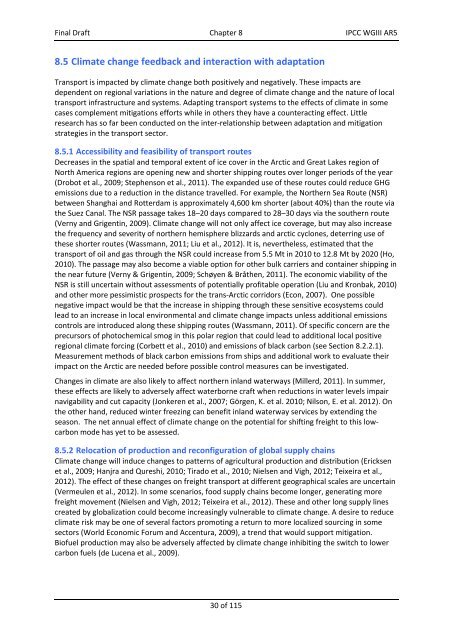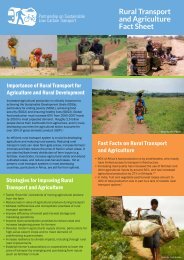ipcc_wg3_ar5_final-draft_postplenary_chapter8
ipcc_wg3_ar5_final-draft_postplenary_chapter8
ipcc_wg3_ar5_final-draft_postplenary_chapter8
You also want an ePaper? Increase the reach of your titles
YUMPU automatically turns print PDFs into web optimized ePapers that Google loves.
Final Draft Chapter 8 IPCC WGIII AR5<br />
8.5 Climate change feedback and interaction with adaptation<br />
Transport is impacted by climate change both positively and negatively. These impacts are<br />
dependent on regional variations in the nature and degree of climate change and the nature of local<br />
transport infrastructure and systems. Adapting transport systems to the effects of climate in some<br />
cases complement mitigations efforts while in others they have a counteracting effect. Little<br />
research has so far been conducted on the inter‐relationship between adaptation and mitigation<br />
strategies in the transport sector.<br />
8.5.1 Accessibility and feasibility of transport routes<br />
Decreases in the spatial and temporal extent of ice cover in the Arctic and Great Lakes region of<br />
North America regions are opening new and shorter shipping routes over longer periods of the year<br />
(Drobot et al., 2009; Stephenson et al., 2011). The expanded use of these routes could reduce GHG<br />
emissions due to a reduction in the distance travelled. For example, the Northern Sea Route (NSR)<br />
between Shanghai and Rotterdam is approximately 4,600 km shorter (about 40%) than the route via<br />
the Suez Canal. The NSR passage takes 18–20 days compared to 28–30 days via the southern route<br />
(Verny and Grigentin, 2009). Climate change will not only affect ice coverage, but may also increase<br />
the frequency and severity of northern hemisphere blizzards and arctic cyclones, deterring use of<br />
these shorter routes (Wassmann, 2011; Liu et al., 2012). It is, nevertheless, estimated that the<br />
transport of oil and gas through the NSR could increase from 5.5 Mt in 2010 to 12.8 Mt by 2020 (Ho,<br />
2010). The passage may also become a viable option for other bulk carriers and container shipping in<br />
the near future (Verny & Grigentin, 2009; Schøyen & Bråthen, 2011). The economic viability of the<br />
NSR is still uncertain without assessments of potentially profitable operation (Liu and Kronbak, 2010)<br />
and other more pessimistic prospects for the trans‐Arctic corridors (Econ, 2007). One possible<br />
negative impact would be that the increase in shipping through these sensitive ecosystems could<br />
lead to an increase in local environmental and climate change impacts unless additional emissions<br />
controls are introduced along these shipping routes (Wassmann, 2011). Of specific concern are the<br />
precursors of photochemical smog in this polar region that could lead to additional local positive<br />
regional climate forcing (Corbett et al., 2010) and emissions of black carbon (see Section 8.2.2.1).<br />
Measurement methods of black carbon emissions from ships and additional work to evaluate their<br />
impact on the Arctic are needed before possible control measures can be investigated.<br />
Changes in climate are also likely to affect northern inland waterways (Millerd, 2011). In summer,<br />
these effects are likely to adversely affect waterborne craft when reductions in water levels impair<br />
navigability and cut capacity (Jonkeren et al., 2007; Görgen, K. et al. 2010; Nilson, E. et al. 2012). On<br />
the other hand, reduced winter freezing can benefit inland waterway services by extending the<br />
season. The net annual effect of climate change on the potential for shifting freight to this lowcarbon<br />
mode has yet to be assessed.<br />
8.5.2 Relocation of production and reconfiguration of global supply chains<br />
Climate change will induce changes to patterns of agricultural production and distribution (Ericksen<br />
et al., 2009; Hanjra and Qureshi, 2010; Tirado et al., 2010; Nielsen and Vigh, 2012; Teixeira et al.,<br />
2012). The effect of these changes on freight transport at different geographical scales are uncertain<br />
(Vermeulen et al., 2012). In some scenarios, food supply chains become longer, generating more<br />
freight movement (Nielsen and Vigh, 2012; Teixeira et al., 2012). These and other long supply lines<br />
created by globalization could become increasingly vulnerable to climate change. A desire to reduce<br />
climate risk may be one of several factors promoting a return to more localized sourcing in some<br />
sectors (World Economic Forum and Accentura, 2009), a trend that would support mitigation.<br />
Biofuel production may also be adversely affected by climate change inhibiting the switch to lower<br />
carbon fuels (de Lucena et al., 2009).<br />
30 of 115



